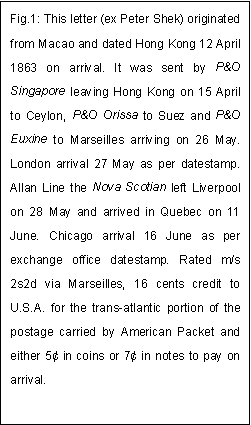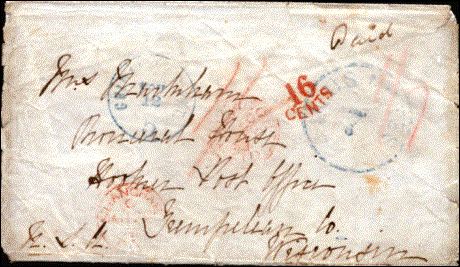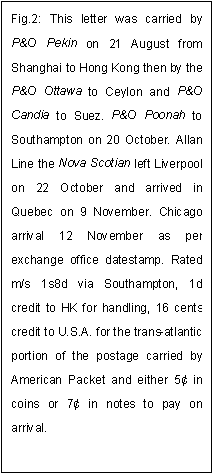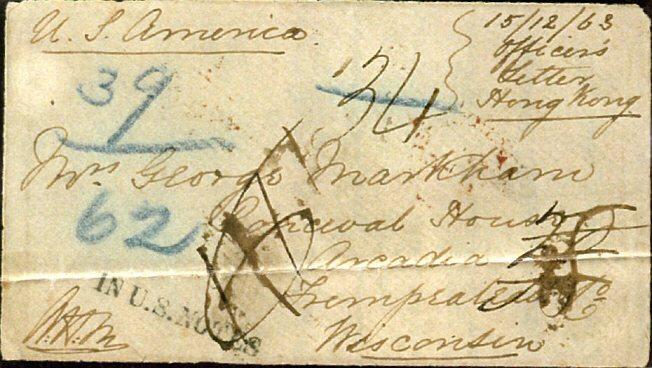The inflation caused by the American Civil War of the 1860s resulted in a monetary crisis in December 1861 when the U.S. Treasury suspended bank payment in gold and silver. Paper currency was introduced two months later which drove gold and silver coinage temporarily almost out of circulation. Further inflation took place and floods of paper currency led to a drop in the value of the US dollar in gold equivalent of more than 30 %.
The U.S. Post Office faced particular problems with international mail, because accounting was based in gold. Because of the heavy losses due to depreciation of the U.S. dollar, the U.S. PMG gave discretionary powers to vary the amounts of postage that were to be collected in the U.S. in notes, according to the daily inflation rates. Incoming letters with postage to be collected could be paid either in “Notes” or “Silver coins”, thus two markings, one indicating paper currency rate “Notes” and the other in silver coins were struck simultaneously. Rates were computed daily on the basis of silver coins to the greenbacks and the worse the depreciation, the bigger the difference between the amount to pay. Many different types of handstamps used by U.S. exchange offices have been recorded from May 1863 to 1878.
When Hong Kong stamps were brought into use in March 1863, new rates to U.S.A. became 1s8d (40¢) per half oz. via Southampton and 2s2d (52¢) for half oz. via Marseilles. These short lived rates lasted until November 1863 when they were changed again to 1s10½d (eqv. to 46¢) per half oz. via Southampton and 2s2½d (eqv. to 54¢) per half oz. via Marseilles. Also from December 1863 onwards, full prepayment was required on mail sent between HK and the U.S.A. and prepayment by stamps from the Treaty Ports was required from 15 Oct. 1864 onwards.
A cover on p.84 of the book “The Gold medal collection of Peter Shek” is known from this period. This April 1863 letter from Macao bears a Chicago 5¢ “Currency” to pay mark and a “7¢ U.S. notes” to pay mark. (Fig.1)
Another August 1863 cover from Shanghai to Wisconsin – part of the famous Markham correspondence was recently offered in a British auction. The letter was prepaid from Shanghai to Great Britain bearing the small s/r Shanghae Paid c.d.s. with the rest of the trans-atlantic portion of the postage to be collected on arrival. On arrival a Chicago 5¢ “Currency” mark and a circular “In U.S. Notes 7¢” both in blue, were applied. (Fig.2)
These two letters must be the very few known from Hong Kong and the Treaty Ports during the period between March 1863 to December 1863 when partial payment was accepted for letters to the U.S.A. bearing dual postage due markings.





The third cover belongs to our member Mr. Norman Bennett FRPSL who is also President of the Hong Kong Study Circle. This cover dated 15 December 1863 from Hong Kong to Wisconsin, U.S.A. is part of the well-known Markham correspondence. The letter was from Albert Hastings Markham who was an Officer serving in HMS Centaur at Hong Kong to his sister-in-law. As an Officer’s letter, this was entitled to a concessionary rate of either 6d via Southampton or 9d if routed via Marseilles. The crossed out “6” suggests that the letter did not go via Southampton but although not marked Via Marseilles, did go through France. On this assumption, carriage would initially have been made by the following P&O ships: –
P&O Orissa: Hong Kong (15.12.63) to Galle (29.12.63)
P&O Mooltan: Galle (31.12.63) to Suez (15.1.64)
P&O Vectis: Alexandria (19.1.64) to Marseilles (25.1.64) and then London across France
Cunard ship Africa from Liverpool (6.2.64) to Boston on sunday 21.2.64
The following datestamps are on the reverse of the cover: London JA 30 64 and Boston Br. Pkt. FEB 23
In London, having deleted the “6”, an erroneous debit was then made to the U.S., viz. 9d rate to the U.K. via Marseilles plus a 2d transit charge (French) = 11d or 22c U.S. To this was added the normal 16c or 8d trans-atlantic rate to total 38c – as shown on the bottom right of the cover. This error was also deleted in favour of the 9d or 18c via France plus 16c trans-atlantic = 34c, shown in black pen as a debit to the U.S.
On arrival the Exchange Office in Boston added the US 5c internal postage (per the US/British Treaty of 1848 rates) to total of 39c. The “34” was deleted by the same blue crayon to avoid confusion. Because of the Civil War, settlements with Britain had to be made on a gold/silver basis but, with no coins being available, the amount due in depreciated U.S. Notes was shown as 62c – a depreciation rate of 1.59 which agrees with Starne’s ratio of 1.50 for 15 January 1864.
The handstamp IN U.S. NOTES is yet another of these Depreciated Currency handstamps used during that time.
Reference: –
History of Letter Post Communications between the United States and Europe 1845-75 by George E. Hargest
North Atlantic Mail Sailings 1840-75 by W. Hubbard and Richard F. Winter
British Maritime Postal History Vol.2 by R. Kirk